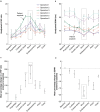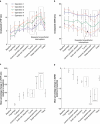Heart rate variability as a dynamic marker of surgeons' stress during vascular surgery
- PMID: 39270744
- PMCID: PMC11398904
- DOI: 10.1093/bjsopen/zrae097
Heart rate variability as a dynamic marker of surgeons' stress during vascular surgery
Abstract
Background: A surgeon experiences elevated stress levels when operating. Acute stress is linked to cognitive overload, worsening surgical performance. Chronic stress poses a significant risk to a surgeon's health. Identifying intraoperative stress may allow for preventative strategies that reduce surgeons' stress and subsequently improve patient outcomes. The aim of this study was to assess the feasibility of using heart rate variability as a marker of stress during vascular surgery.
Methods: A total of 11 senior surgeons were evaluated performing three different vascular surgery procedures. Heart rate variability metrics (low-frequency to high-frequency ratio and standard deviation of the normal-normal interval) were determined from single-lead ECG traces at predetermined procedural performance points. State-Trait Anxiety Inventory-6, a validated stress tool, was used to assess surgeon-reported stress. Subjective reports of procedural difficulty were also collected. One-way ANOVA compared heart rate variability at key performance points with baseline. Pearson's coefficient assessed correlation between heart rate variability and subjective stress.
Results: Data were collected for six carotid endarterectomies, six open abdominal aortic aneurysm repairs, and five lower limb bypasses. Heart rate variability metrics indicating markedly greater stress were observed at key performance points across all procedures. Peaks in stress were consistent across different surgeons performing the same procedure. A significant correlation was observed between heart rate variability metrics and subjective State-Trait Anxiety Inventory-6 stress reports (r = 0.768, P =<0.001). The most difficult procedural steps reported corresponded with heart rate variability metrics displaying the greatest stress.
Conclusion: Heart rate variability may be a viable approach to assess intraoperative stress and cognitive load during vascular surgery and could be used to evaluate whether a theatre intervention (for example timeout) could reduce stress in areas of surgical difficulty.
© The Author(s) 2024. Published by Oxford University Press on behalf of BJS Foundation Ltd.
Figures





Similar articles
-
Assessing surgeon stress when operating using heart rate variability and the State Trait Anxiety Inventory: will surgery be the death of us?Colorectal Dis. 2015 Apr;17(4):335-41. doi: 10.1111/codi.12844. Colorectal Dis. 2015. PMID: 25406932
-
Heart rate and heart rate variability as indirect markers of surgeons' intraoperative stress.Int Arch Occup Environ Health. 2014 Feb;87(2):165-74. doi: 10.1007/s00420-013-0847-z. Epub 2013 Feb 1. Int Arch Occup Environ Health. 2014. PMID: 23370764
-
Assessing surgeon stress during urological interventions: A descriptive study using heart rate variability (uRRology).Fr J Urol. 2025 Mar;35(2):102837. doi: 10.1016/j.fjurol.2024.102837. Epub 2024 Dec 4. Fr J Urol. 2025. PMID: 39643041
-
Systematic review of measurement tools to assess surgeons' intraoperative cognitive workload.Br J Surg. 2018 Apr;105(5):491-501. doi: 10.1002/bjs.10795. Epub 2018 Feb 21. Br J Surg. 2018. PMID: 29465749 Free PMC article.
-
Heart rate variability as a measure of mental stress in surgery: a systematic review.Int Arch Occup Environ Health. 2020 Oct;93(7):805-821. doi: 10.1007/s00420-020-01525-6. Epub 2020 Mar 25. Int Arch Occup Environ Health. 2020. PMID: 32215713 Free PMC article.
Cited by
-
Daily physical activity habits influence surgeons' stress in the operating room: a prospective cohort study.Int J Surg. 2025 Mar 1;111(3):2505-2515. doi: 10.1097/JS9.0000000000002258. Int J Surg. 2025. PMID: 39903564 Free PMC article.
References
-
- Arora S, Sevdalis N, Nestel D, Woloshynowych M, Darzi A, Kneebone R. The impact of stress on surgical performance: a systematic review of the literature. Surgery 2010;147:318–330.e1–e6 - PubMed
-
- Demirtas Y, Tulmac M, Yavuzer R, Yalcin R, Ayhan S, Latifoglu O et al. Plastic surgeon’s life: marvelous for mind, exhausting for body. Plast Reconstr Surg 2004;114:923–931, discussion 932–933 - PubMed
-
- Selye H. The evolution of the stress concept. Am Sci 1973;61:692–699 - PubMed
MeSH terms
LinkOut - more resources
Full Text Sources
Medical

